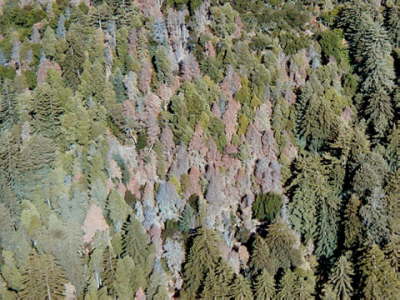Warmer and wetter weather is good for tree diseases, which is bad news for trees

Climate change is likely to wreak havoc on California’s forests. Extreme weather, wildfires and insect outbreaks will all take a toll. Add to those another looming threat: disease. Forest diseases like Sudden Oak Death, which has infected trees in 14 counties in the state, stand to benefit from the effects of climate change, to the detriment, obviously, of the trees.
Trees are big and long-lived. Tree pathogens, mostly fungi and bacteria, are the opposite. They’re mobile, able to blow around on the wind. And they reproduce and evolve rapidly. That’s the crux of the problem, according to Susan Frankel, a plant pathologist with the Forest Service.
“When you look at forest health and the balance between forest trees and the pathogens that attack them, it does seem, given climate change, pathogens get the better end of the deal,” she told me.
Frankel is working with a group of ecologists, funded by the Forest Service’s Western Wildland Environmental Threat Assessment Center, to better understand how climate change will affect tree diseases. In a recent report, they outlined possible impacts:
- Range and distribution of tree diseases will change.
- Warmer winter temperatures won’t kill pathogens that have historically been limited by cold weather.
- Prediction of disease outbreaks will me more difficult.
- The rate of evolution of tree diseases may increase.
- Other stressors caused by climate change — for instance, drought — will make trees more susceptible to disease.
- Climate change may open the door to invasions by non-native forest diseases.
Frankel is especially interested in Sudden Oak Death, which has killed more than a million trees in California. It needs moisture to spread and reproduce, and it thrives in warmer temperatures. “The pathogen blows in wind-blown rain,” Frankel explained. “It loves the weather we’re having right now.”
The study from the Forest Service weighs two possible future climate scenarios: warmer and wetter or warmer and drier. It finds, for the warmer and wetter option, increased damage from Sudden Oak Death is “High (very certain).” The warmer and drier option is “Low (moderately certain).”
The other diseases Frankel and her colleagues examined were Dothistroma Needle Blight, Swiss Needle Cast, White Pine Blister Rust, Cytospora Canker of Alder, Dwarf mistletoes, Armillaria Root Disease and Yellow-Cedar Decline.
One thought on “How Climate Change Makes Trees Sick”
Comments are closed.


so if the golden oak borer doesn’t kill the oaks, SOD will do it.